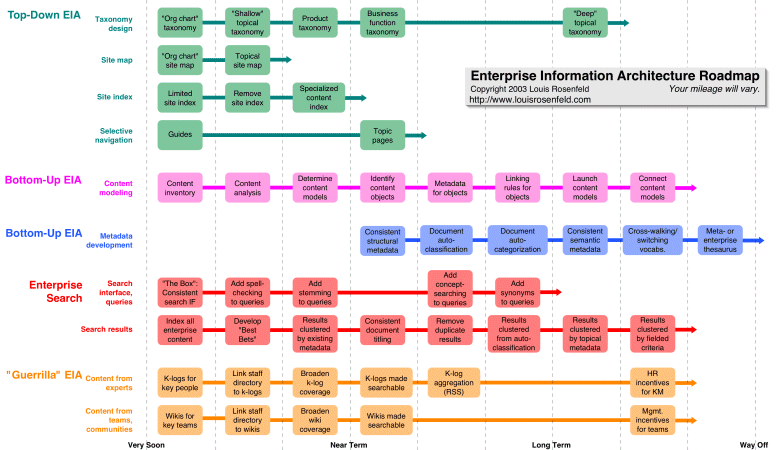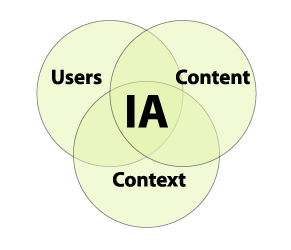Feature Article
Information Architecture is Just Plain Fun!
An Interview with Lou Rosenfeld
Lou Rosenfeld
Information Architecture Consultant
lou@louisrosenfeld.com
In planning the second issue of The Rockley Report, it was unanimous that an issue on Information Architecture would not be complete without hearing from Lou Rosenfeld, information architecture "guru" and co-author of Information Architecture for the Word Wide Web, now in its second edition. We posed a number of questions to learn how he got involved in information architecture, his views on information architecture for the web, and how he sees information architecture extending beyond the web, potentially to all content created, used, and stored throughout an organization. According to Rosenfeld, "structuring, labeling, and organizing information is just plain fun. Well, at least for the oddfellows among us who are into that sort of thing." We happen to agree and are happy to share with you our interview with Lou Rosenfeld. Be sure to also check out Rosenfeld's web site at
www.louisrosenfeld.com.
Q. What is your background?
After receiving a BA in history from the University of Michigan in 1987, I spent a short stint in that hell-on-earth known as retail sales. That experience chased me back to school, where a masters in library science seemed like a safe bet. I'd heard that there were lots of new information technologies that could prove useful both within and outside the library environment.
In those days, you only needed to be a month ahead of your peers to be a tech guru among librarians. I managed that float well, taking on various positions at Michigan as an instructor, researcher, and technology manager before ending up back in grad school to begin work on a PhD. Two years at the bottom of that particular pyramid made the dog-eat-dog of the private sector look warm and fuzzy. I'd already begun my consulting firm, Argus Associates, a few years earlier, and I left academia for good in 1994 to devote myself to Argus full-time.
Argus went on to be recognized as the leading consulting firm in information architecture, serving many Fortune 500s and other large enterprises and helping define the profession along the way. Argus reached approximately forty employees before flaming out in 2001, when corporations suddenly erased the budget line item that covered consulting services in new, abstract, difficult-to-prove-ROI, yet extremely important areas like information architecture. Since then I've been an independent IA consultant (more about me at www.louisrosenfeld.com).
Q. What drew you to Information Architecture?
Let's face it: structuring, labeling, and organizing information is just plain fun. Well, at least for the oddfellows among us who are into that sort of thing.
Looking forward from, say, 1994, IA presented unexplored terrain as the Web and related technologies were beginning to explode. Someone was going to have to organize all that content.
And finally, how many opportunities do we get to help define and develop a new profession? Everyone involved in IA is doing just that; it's hard not to be drawn to a field that is growing and morphing before your eyes.
Q. What factors made it clear to you that information architecture is required for effective web sites?
Even ten years ago, both end users and content managers were straining under the weight of huge, complex web sites and other information systems. It was clear that this scalar problem was only going to get worse for two reasons. The first we all know about: the information explosion that, according to some, is doubling humanity's total output of information every five years. The second, lesser-known factor was described to me by a client at AT&T as "ROT": Redundant, Outdated, and Trivial content. What's good today will be ROT tomorrow. IA can help both content managers and end users deal with these problems be helping make ever-larger information systems better at supporting findability, while providing guidance in minimizing content ROT.
Q. Recently you have been doing a lot of work in the area of Enterprise Information Architecture. Can you describe this area and its value to organizations?
Generic or "traditional" IA is agnostic in terms of how best to design and implement an information architecture-just use the methods that make the most sense, choose the subset of ways to connect users to content that gives you the most bang for your buck, and so forth. IA "textbooks" like Information Architecture for the World Wide Web (Louis Rosenfeld & Peter Morville, O'Reilly & Associates, 2002) present a broad palette of architectural options, and it's up to the information architect to choose wisely.
Enterprise IA, by contrast, is much more proscriptive. The enterprise setting is typically a large information space made up of disjointed silos controlled by different business units. Users are confronted by a counter-intuitive architecture that closely resembles the enterprise's org chart. Politics, culture, geography, technology, and other interesting constraints complicate this particular context. Enterprise IA is a unique IA genre, as are the architectures for ecommerce sites or entertainment sites. So we can prioritize and often proscribe which aspects of an IA will succeed in this particular genre and which won't.
For example, for obvious reasons it's difficult to manually tag all documents using controlled vocabulary terms in an enterprise environment. It's easier to implement site-wide search, which doesn't necessarily require bothering content authors or manually touching their content. We can look at the entire IA palette and make some reasonable suggestions as to what will work in an enterprise environment, what won't, and when. I've captured my suggestions in this "Enterprise IA Roadmap" which, at worst, is a straw man for guiding enterprise information architects as they make their IA choices:

I use this diagram as the basis for the design aspects of my seminar on Enterprise Information Architecture (www.louisrosenfeld.com/presentations/seminars/eia/).
My hope is that a well-designed enterprise IA will not only aid users in their efforts to find information in the enterprise environment, but also save information architects-and their employers-from wasting huge amounts of time and money as they try to develop useful, findable content.
Q. Tell us about the methodologies you used to develop best practices for information architecture for the web.
Individual methods are interesting, but the important thing is to assemble and utilize a whole bunch of them in a logical way. So instead of talking about individual methods, I think it's better to think about how they fit together. My take on IA methodology is addressed by the Venn diagram below (reader warning: you're reading an interview with a consultant, so what did you expect?):

A well-designed information architecture maps the needs of users to available content, all against the backdrop of a specific business context. The methods used should help us better understand all three areas, so we'd better take a balanced approach to selecting the methods we'll use on a given project.
For example, I might utilize card-sorting and search log analysis to understand what's inside users' heads, content inventory and modeling to know what content is available and how its pieces relate to each other, and stakeholder interviews, resource analysis, and competitive benchmarking to make sure that the IA design would work well in a given business context. For various reasons, I might use a different set of methods for another project, but the key is always to maintain balance across users, content, and context.
Q. Do you feel that the term information architecture is confined to the Web? Please explain.
Absolutely not. Consider the information architecture of that most familiar information system, the book.
Well, it's kind of hard, isn't it? We take tables of contents, indices, pagination, chapters, and the details on the spine and cover for granted. After all, we grow up using this medium and its conventions.
Designers of Web sites, on the other hand, don't benefit from the trial and error of centuries of predecessors. And Web sites allow for designs that are much more flexible and therefore more complex. That's why people are so interested in IA for web sites when compared with traditional media; there are precious few conventions, and we can influence what may ultimately become conventions.
Of course, if the pundits are right, the Web and other media will all eventually converge, rendering this debate moot.
Q. In the last issue of The Rockley Report, you provided a quote for our article on the "Information Architecture of Content Management." Can you describe what IA for CMS entails? Where do you see IA for CMS fitting into the area of IA?
Sorry to over-anthropomorphize here, but I see information architecture gleefully holding a squirming content management's feet to the fire, ensuring that CM, in its zeal to support those users known as content owners, doesn't forget those other users, namely end users.
I remember attending my first CM conference a few years ago and being dumbstruck at how surprised many attendees were when they were reminded that their work impacts end users. What's the point of doing CM if end users are left out of the equation? IA provides tools, techniques, and expertise to help content management benefit from metadata and integrate well with search and navigation systems, thereby delivering value to end users and content owners alike.
You might also say that IA provides a model for how CM might develop as a profession. IA is technology-agnostic. Until content managers start thinking this way, and focus on users and the processes that serve them, CM will continue to be dominated by CMS vendors to the detriment of all.
Q. Where do you see information architecture going in the future?
I'm convinced we'll see two major growth areas over the next decade: 1) IA for enterprise environments; and 2) IA for global environments, where L10n and i18n become critical design considerations. I'm starting to see many clients grappling with both areas concurrently.
As far as where IA is practiced, many of us witnessed the exodus of information architects from agencies to in-house positions over the past four years. Information architects were often hired in the wake of troubled CMS and search engine implementations, where it was realized that technology alone couldn't solve all the world's ills.
However, as the population of in-house information architects reaches a critical mass, many senior IAs are leaving the warm embrace of full-time employment to provide either strategic or highly-specialized consulting and training to support those in-house folks. I'd be surprised if the same thing wasn't happening in CM.
Q. How would you recommend someone get started in IA?
You can now actually get an advanced degree in information architecture. If you'd like to know more, the Asilomar Institute for Information Architecture provides useful links to IA education resources
(www.aifia.org/pg/education.php).
But if you don't have a couple of spare years to pursue another degree, I'd return to my three-circle Venn diagram.
Consider "majoring" in one of those circles and "minoring" in the other two. For example, maybe you're already quite knowledgeable about
context-you might have a background in organizational psychology or management, and having worked at your company for a dozen years, you know more than you'd like about its particularities. With business context as your "major," you might begin your "minor" in
users by reading books on human-computer interaction or reference librarianship, and you might learn more about
content by attending a conference on technical communication or hanging around with the journalists who congregate at your local watering hole.
However you pursue your studies, formal or informal as they may be, seek balance among those three circles and you'll be in great shape.
| 
